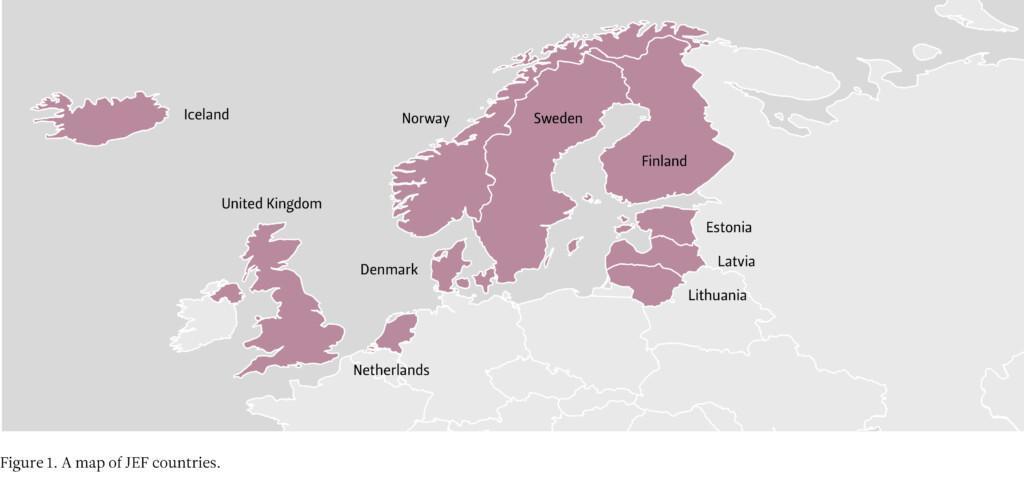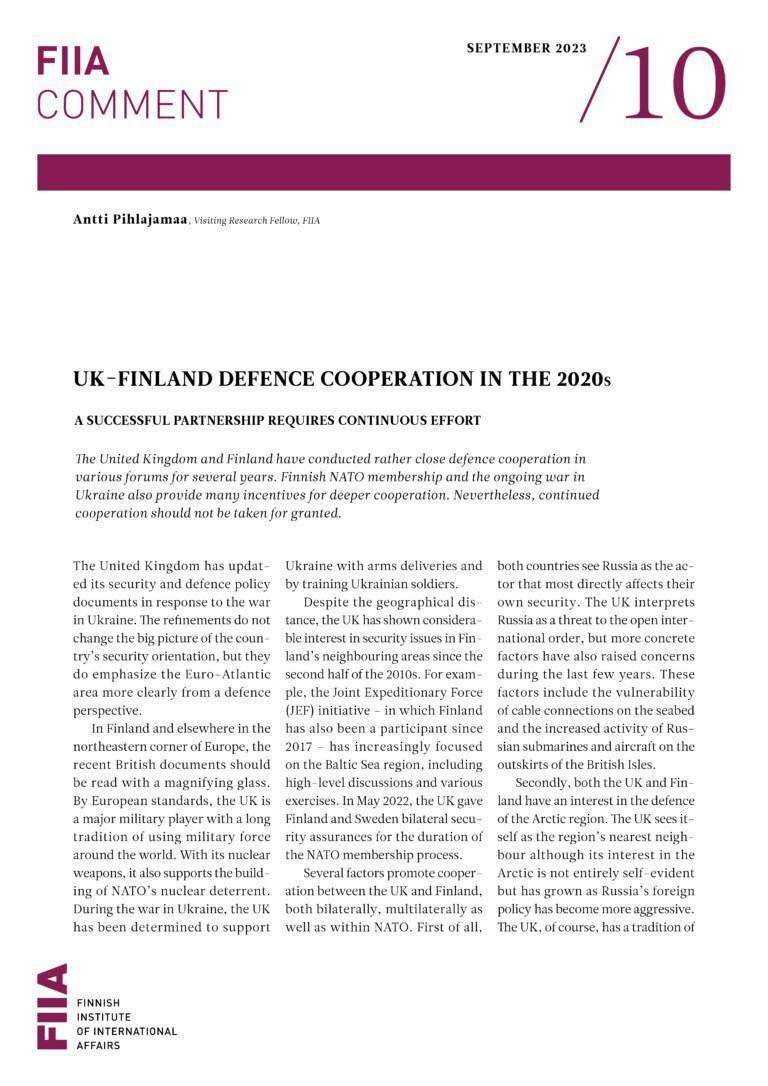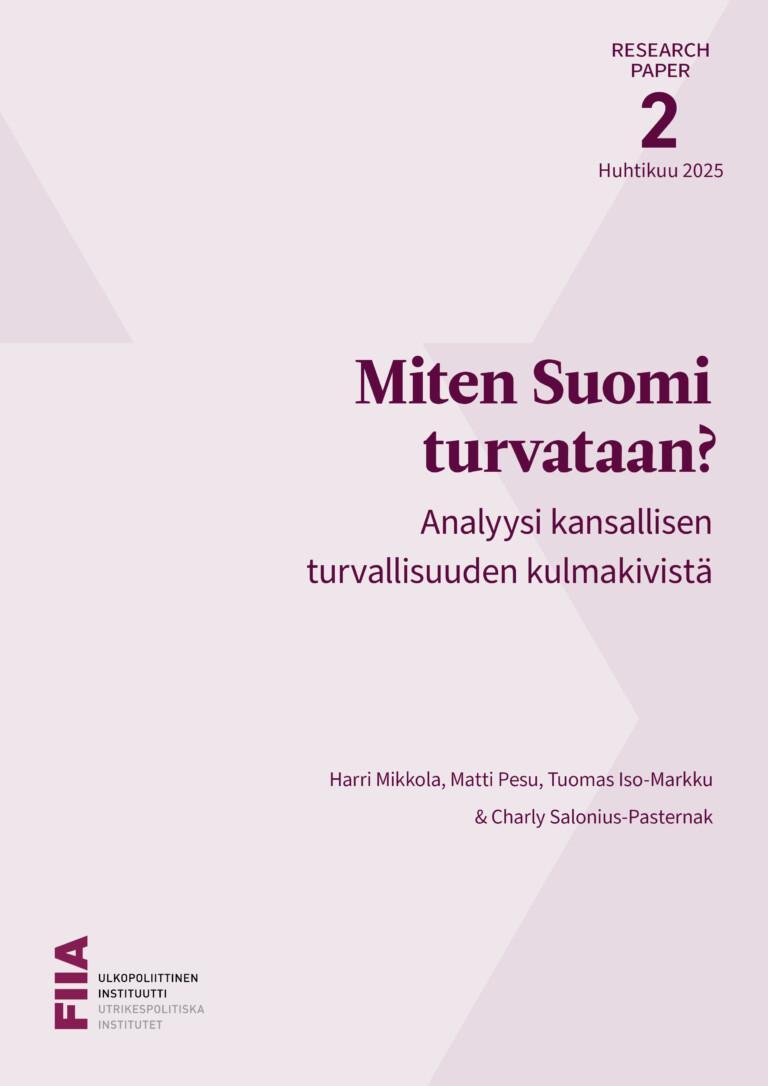
The Joint Expeditionary Force – a UK-led defence cooperation format of ten European countries – has gained political momentum since the Russian invasion of Ukraine in 2022.
Since the late 2010s, the JEF has shifted its focus towards hybrid issues, increasingly in Northern Europe. While its role in the hybrid sphere is potentially fruitful, the JEF should be wary of taking on too wide a range of tasks.
The JEF’s role as a “sub-threshold” actor could complement NATO’s collective defence efforts below Article 5. Hence, the JEF should be more coherently integrated into the Northern European security architecture. Obstacles to JEF-NATO integration have now been removed, as all JEF nations are also members of the alliance.
A more explicit division of labour between the JEF and NATO would help Northern European countries to handle the current security environment comprehensively. Such a security architecture, covering all dimensions of the conflict spectrum, would be particularly beneficial for Finland, which shares a long common border with Russia.
Introduction
Since the beginning of the full-scale Russian invasion of Ukraine in 2022, the Joint Expeditionary Force (JEF) – a defence cooperation format of ten European countries led by the United Kingdom – has gained increased political momentum. After the Balticconnector gas pipeline damage in the Gulf of Finland in October 2023, the JEF activated a so-called Joint Response Option (JRO) to improve the security of undersea infrastructure through exercises and patrols in the Baltic Sea, the Norwegian Sea, as well as UK waters.
The JRO mission, an operational-level activity including both maritime and air capabilities, emphasizes the role that the JEF has taken on in countering hybrid threats below the threshold of war. However, this recent example of JEF activation does not fully capture all dimensions of the Northern European security environment. Besides hybrid threats, there is also increasing consciousness in Europe of the possibility of overt military aggression. Therefore, military security needs to be handled both below and above the threshold of war.
This Briefing Paper argues that the JEF should be more explicitly linked to the security and military architecture of Northern Europe, where NATO has a priority role. The JEF has always been designed to complement NATO, but its role in relation to the alliance should be further clarified. Two factors support this notion: First, as every JEF country is now a NATO member, there are no longer obstacles to closer JEF-NATO integration. Second, although NATO has intensified its collective defence efforts and, for example, adopted regional defence plans at the 2023 Vilnius Summit, there is room for more agile formats, such as the JEF, below the threshold of Article 5. However, these sub-threshold efforts by military organizations should be military in nature and build a continuum of actions in relation to NATO.
This paper consists of three parts. First, it briefly presents a timeline starting from the early 2010s, when the JEF began to outline its role and gradually shifted its focus to Northern Europe. Second, it looks more specifically at the JEF’s role as a sub-threshold actor, without forgetting the limitations of this approach. Finally, the paper suggests that a more coherent integration of the JEF into the Northern European security architecture should be considered.
Discovering the role of the JEF in the 2010s
The JEF was discussed in public for the first time in December 2012. The then Chief of the UK Defence Staff, General Sir David Richards, gave a speech in which he outlined his vision of the JEF as “an integrated joint force with capabilities across the spectrum at sea, on land and in the air”.[1] Two years later, at the NATO Summit in Wales in September 2014, a letter of intent on the development of the JEF was signed between the UK and six other nations (Denmark, Estonia, Latvia, Lithuania, the Netherlands, and Norway). The JEF was described as a pool of high-readiness forces designed to respond rapidly anywhere in the world. A force of up to 10,000 troops – namely division level – was attached to the JEF.[2]
From the outset, the JEF was characterized by several distinctive features. First, it was intended to be complementary to NATO, as part of NATO’s Framework Nations Concept. Although NATO had enhanced its own rapid reaction force (NATO Response Force) by creating the Very High Readiness Task Force, it did not appear to be easy for all 29 NATO countries to reach a consensus on deploying these troops. Second, the JEF was to have a wide range of tasks, from humanitarian missions to high-intensity warfighting, either by British troops alone or multilaterally. Despite the NATO link, it was to be available for UN, NATO, and EU operations. Third, and related to the previous point, flexibility was at the core of the JEF. This meant that it was a force pool, not a standing force, allowing for variable force compositions depending on the mission. However, the participant countries made at least unofficial commitments to the pool, ranging from Norwegian air and maritime forces to Baltic company-sized land units and Dutch amphibious forces,[3] which were to be deployed “in accordance with stated readiness”.[4]
In June 2017, Finland and Sweden joined the JEF, leading the group to diverge from its exclusive reliance on the NATO framework. This shift also implicitly redirected the JEF’s focus towards Northern Europe, instead of its initial emphasis on the Middle East. The Baltic Protector exercise in 2019 was the first JEF deployment. This exercise was seen to reflect the JEF’s strengths: “The JEF can act while NATO is thinking” was an often-used phrase, referring to the like-mindedness of the then nine participant JEF countries. Additionally, the opt-in principle, whereby participant countries would be determined case by case for every mission, was seen as increasing flexibility and thus adding value in the tense security environment where Russia’s ability to generate surprise was seen as its centre of gravity. It was hoped that the JEF would respond effectively to such unexpected developments.
All in all, by the end of the 2010s, the JEF was seen as a rapid response force for various contingencies. Its limited size and desired high readiness reflected the “early in, early out” principle, but its geographical scope started to turn towards Northern Europe, instead of the broader visions of the past.

A multinational interagency actor in the early 2020s?
The focus of the JEF was redirected in the early 2020s, with the new JEF Policy Direction in summer 2021 laying the foundations for its evolution. It recognized that the nature of security challenges had changed since the first visions of the JEF in 2012. Constant competition and confrontation were now seen as an integral part of the reality of the security environment. As the traditional boundaries between war and peace were disappearing, the JEF should also be able to respond to “sub-threshold” challenges. These refer to hostile activities that do not rise above the threshold of war, namely NATO’s Article 5, but are malicious and intentional, with the aim of disrupting target societies. Relying solely on military measures was no longer seen as sufficient, but it was recognized that the security environment “may require bringing together the military instrument with other levers of government”. At the same time, the principal geographical area was explicitly stated to be the High North, North Atlantic, and the Baltic Sea region. [5] The addition of Iceland as the tenth JEF country in 2021 further solidified the group’s commitment to these regions.
In addition to the new non-military tools, the nature of JEF operations was also seen to be changing. The JEF was still regarded as a rapid reaction force when needed; however, according to the Policy Direction, it was also expected to operate “persistently below the threshold of crisis or conflict”. It seems that the JEF should be ready to operate continuously, even in the absence of specific incidents or stimuli, leaning towards a kind of “fleet in being” philosophy, where the idea is that even small, but continuously operating forces can deny an adversary’s operational freedom of movement by compelling it to engage forces large enough to defeat the smaller one.
This new vision of the JEF was tested and further elaborated in the Joint Protector 21 command post exercise in Sweden. One conclusion drawn from the exercise was that “for JEF to be able to successfully operate in sub-threshold situations, more and different non-military expertise is required at the headquarters”.[6] However, it is worth asking to what extent and how the JEF should be able to operate in this regard. The idea of the JEF as a persistently operating whole-of-government or even whole-of-society force is problematic in practice from two perspectives.
First, a purely military solution is rarely sufficient in hybrid scenarios. Overall, the use of military force in hybrid incidents requires careful consideration, especially in the case of a coalition of the willing, such as the JEF. The interoperability of such a coalition may vary, potentially weakening its military effectiveness. Furthermore, it is important to consider whether there is any added value in a multinational military actor – unfamiliar with the national culture, legislation and so on – attempting to coordinate the activities of national civilian authorities that do not necessarily want to be coordinated by a military organization. Moreover, there might be legislative or bureaucratic restrictions that prevent armed forces from taking the lead in many hybrid threat scenarios. In many countries, these are clearly police issues, and the armed forces may take a supporting role.[7] In short, a military organization is most useful in hybrid scenarios when deployed in situations where it is genuinely suitable, without attempting to overload it with an excessively broad range of tasks. While having a military tool at hand, it is important to acknowledge that not every problem should be seen as requiring a military solution.
Second, and from a more conceptual perspective, the need to operate persistently is not easy to argue for or execute because of insufficient national military capabilities. Many European – including JEF – countries are struggling with small troop numbers and too little equipment in the context of the Russian invasion of Ukraine. After the end of the Cold War, many armed forces were streamlined in keeping with the changed threat perceptions, and defence expenditures are only now beginning to shift course. It is therefore difficult to imagine that the JEF countries would commit their scarce resources to persistent operations without some recognized impetus to react militarily, given that commitments could even hinder the required contributions to NATO’s collective defence, which is the bedrock of the security of most European countries.
This does not mean that the JEF could not have a role in a sub-threshold environment, but that the role must be appropriate for a military organization. There is some indication that the role that the JEF is designing for itself already considers this aspect, at least to some extent. The new JEF Vision from 2023 seems to withdraw somewhat from the ambition of operating permanently. It talks about “operating together continuously”,[8] which is a somewhat milder formulation than before. Moreover, the vision states that the broader levers of national power, meaning at least the civilian authorities, will be brought together “where appropriate” rather than automatically. Finally, it also acknowledges the need to “integrate and contribute to NATO deterrence at all times”, which is a clear indication of a closer NATO integration effort.
Besides the new Vision, the JEF has outlined so-called JEF Response Options (JROs), which are “designed to deter, and defend our region from threats and establish how we can quickly respond to crises”.[9] The first of these was activated in late November 2023 in response to the Balticconnector incident in the Gulf of Finland in early October. This JRO was pre-planned, but not the only one that had been prepared. The JEF had developed a series of options throughout 2023. These were to form the basis for the JEF’s development, even though the number and scope of the scenarios they addressed were not articulated in public. However, the options were intended to provide military options in times of crisis, not broad, whole-of-government solutions.
In conclusion, the ambition to develop the JEF into a facilitator for the activities of multinational and interagency authorities now appears to have receded into the background somewhat. This may be due to the return of large-scale warfare in Europe since 2022, but also to the differing views of the JEF nations on the extent to which the JEF should play a role in non-military issues. Another interesting feature in the recent evolution of the JEF is the more prominent role of NATO. These ideas may indicate that the JEF is partially returning to its original role as a rapid response force rather than “a fleet in being”. However, the sub-threshold environment seems to be the JEF’s niche, which also opens up an avenue for closer NATO integration.
Integrating the JEF into the Northern European security architecture
The Northern European security architecture has changed significantly since 2022. The most obvious shift took place when Finland and Sweden joined NATO in 2023 and 2024, respectively, in response to the Russian invasion of Ukraine in 2022. Russia’s reactions to Finland’s NATO accession have so far remained mostly in the hybrid sphere. The most prominent example is Finland’s eastern border, where Russia attempted to intimidate Finland by facilitating waves of migrants in late 2023 in order to break the cohesion of Finnish society, test its reactions, and strain the resources of the Finnish authorities. These events underline the continued significance of hybrid threats in the post-2022 context. At the same time, a consensus is emerging in Europe that Russia will rebuild its military power when the war in Ukraine ends sooner or later, emphasizing the renewed significance of conventional large-scale military capability.
For the JEF, this new reality, in which all dimensions of the conflict spectrum are present, is meaningful for three reasons. First, as noted earlier, the role that the JEF has adopted as a sub-threshold actor addressing hybrid threats is potentially fruitful. Incidents of deliberate damage to critical infrastructure, such as the Nord Stream and Balticconnector gas pipelines, have demonstrated the relevance of coordinated sub-threshold military activities. However, as a consensus-seeking organization with 32 members, NATO might not be agile enough to react in a sufficiently short timeframe. Moreover, limited hybrid incidents on one flank of the alliance do not necessarily seem to require a NATO-wide response. Thus, there is a need for more regionally focused solutions.
Second, the obstacles to JEF-NATO integration have now been removed, as all JEF nations are also members of the alliance. The integration is essential due to the scarcity of resources in the armed forces of many European countries. They hardly have separate JEF and NATO capabilities on their roster, meaning that the use of these capabilities must be planned and executed with great care. Even more importantly, further JEF-NATO integration could foster more coherent handling of the whole spectrum of conflict, from peacetime to crisis and war.
In practice, JEF-NATO integration would mean more explicit synchronization of JEF Response Options and NATO’s regional defence plans. These JEF and NATO plans cover different phases of the conflict spectrum and are therefore complementary rather than competing. The JROs are clearly below the threshold of Article 5, while NATO’s regional plans are to be executed in the event of open military aggression. There is, however, one striking difference between the plans: NATO’s regional plans are existential from the perspective of many countries. The significance of JROs is not necessarily at that level. A lurking threat – as with the ability to operate persistently – is that the willingness of nations to contribute to JEF activities might be weak if they are seen as exhausting military capabilities, and thus compromising the execution of NATO’s collective defence.
That said, it is worth directing more attention to building continuity and coherence between JEF and NATO activities in various phases of the conflict spectrum, and to ensuring a smooth transition from JEF sub-threshold activities to the execution of NATO’s regional plans, considering that the troops and capabilities in these activities may be partially the same. At a minimum, it should be ensured that none of the JEF’s activities (including JROs) compromise the execution of NATO’s regional plans. A closer link between the JEF and NATO would both serve to counter hybrid threats and make participating nations more aware of the usefulness of the JEF.
A potential overlap between the JEF and NATO is further emphasized by the notion that NATO’s so-called DDA concept (the Overall Concept for Deterrence and Defence of the Euro-Atlantic Area) is essentially a war-prevention concept.[10] Thus, JEF activities could make a significant contribution at least to the deterrence part[11] of the DDA in Northern Europe, while ensuring freedom of manoeuvre for the operational considerations of the Supreme Allied Commander Europe (SACEUR), as well as speeding up the execution of NATO’s regional plans, namely the defence part of the DDA. The scale of possible peacetime JEF-NATO integration activities is broad, ranging from the coordination of exercises to forming a Standing NATO Maritime Group within the JEF framework.
Against this background, closer JEF-NATO integration is welcome and seems to have already begun, at least to some extent. According to a joint statement by the leaders of the JEF countries, the JROs outlined in 2023 “are reflected within broader NATO defence plans”. Moreover, another large-scale command post exercise, Joint Protector 24, is to be conducted to rehearse the role of the JEF’s operational headquarters (Standing Joint Force Headquarters) in relation to NATO in a regional security scenario.[12] This indicates that the dynamics of the security environment are well understood at the JEF headquarters in Northwood.
The integration will not be easy. The JEF’s flexibility is not easily compatible with NATO’s commitment ethos: the execution of the JEF Response Options does not entail the same kind of obligation as NATO’s regional plans. To be more clearly integrated into the Northern European security architecture, the JEF needs to consider the extent to which it wishes to maintain flexibility – which is a great strength, particularly politically, but does not always improve military effectiveness. At the same time, excessive overlap should be avoided: besides the JEF and NATO, the EU also has initiatives on the protection of critical national infrastructure, for example.
Conclusions
This paper has argued for more explicit JEF-NATO integration to deal coherently with the current unpredictable security environment, from peacetime to crisis, conflict, and war. Moreover, it has suggested that the sub-threshold role adopted by the JEF may be fruitful in this regard, complementing NATO’s more robust family of plans to defend “every inch” of the alliance’s territory. The JEF may be the regional first responder, if NATO’s Article 5 threshold is not exceeded, or when reaching a consensus takes time. However, the JEF should be wary of taking on too broad tasks. Operating persistently and acting as a coordinator of multinational interagency issues – ambitions outlined in the early 2020s – are not necessarily meaningful. Instead, the JEF’s strength is best utilized when the scenario is limited and compatible with military capabilities.
It seems that the JEF and NATO are currently refining their relationship. JEF HQ understands that there is a need to coordinate the JEF Response Options with NATO regional defence plans. For the JEF, the combination of the current security environment and limited national capabilities means that the operational profile should be well thought through. A balance must be struck between proactive but resource-consuming operating, and a reactive, but sufficiently rapid response capability. Military effectiveness also requires consideration of the optimal balance between flexibility and JEF nation commitments that would facilitate the development of the JROs and other military planning.
More explicit JEF-NATO integration would be desirable for Finland. The country’s border with Russia accounts for half of the total NATO-Russia border, and it is possible that various incidents will take place in the years to come. Despite its limited resources compared to the US, the UK is a valuable partner for Northern European countries, and it is important to ensure that the UK’s commitment to the region remains strong. JEF-NATO integration could serve this purpose. Moreover, the integration would facilitate both deterrence to avoid open military confrontation and defence in the event of a rainy day.
Endnotes
[1] Richards, David (2012) Speech delivered in Royal United Service Institute, London. 17 December 2012. https://www.gov.uk/government/speeches/chief-of-the-defence-staff-general-sir-david-richards-speech-to-the-royal-united-services-institute-rusi-17-december-2012.
[2] HM Government (2014) “International partners sign Joint Expeditionary Force agreement”. 5 September 2014. https://www.gov.uk/government/news/international-partners-sign-joint-expeditionary-force-agreement; Jones, Sam (2014) ”NATO states create new multilateral force”. Financial Times, 29 August 2014. https://www.ft.com/content/5335d904-2f98-11e4-87d9-00144feabdc0.
[3] Saxi, Håkon Lunde (2018) “The UK Joint Expeditionary Force (JEF)”. IFS Insights 5/2018, Norwegian Institute for Defence Studies. https://core.ac.uk/download/pdf/225935409.pdf.
[4] Joint Expeditionary Force (2015) “Foundation Memorandum of Understanding”. November 2015. https://zoek.officielebekendmakingen.nl/blg-671355.pdf.
[5] Joint Expeditionary Force (2021) “Policy direction”. 12 July 2021. https://www.gov.uk/government/publications/joint-expeditionary-force-policy-direction-july-2021/joint-expeditionary-force-jef-policy-direction. See also Zandee, Dick and Adája Stoetman (2023) “Countering hybrid threats. The role of the Joint Expeditionary Force”. Clingendael Report, March 2023, Netherlands Institute of International Relations, 6–7. https://www.clingendael.org/sites/default/files/2023-03/countering-hybrid-threats.pdf.
[6] Zandee and Stoetman 2023, 7. See also Monaghan, Sean (2021) “The Joint Expeditionary Force: Toward a Stronger and More Capable European Defense?”. Commentary, 12 October 2021, Center for Strategic and International Studies. https://www.csis.org/analysis/joint-expeditionary-force-toward-stronger-and-more-capable-european-defense. Joint Protector was also executed in 2022.
[7] Zandee and Stoetman 2023, 7–9.
[8] Joint Expeditionary Force (2023) “The JEF Vision”. 13 October 2023. https://www.government.se/contentassets/c7b847cc5b9f49fc8de64dd0006278f4/jef_vision.pdf.
[9] Ministry of Defence (2023) “Joint statement by Joint Expeditionary Force ministers, November 2023”. 28 November 2023. https://www.gov.uk/government/news/joint-statement-by-joint-expeditionary-force-ministers-november-2023.
[10] See e.g., Moller, Sara Bjerg (2023) “NATO at 75: The Perils of Empty Promises”. Survival 65 (6): 91–118. https://www.tandfonline.com/doi/full/10.1080/00396338.2023.2285606, 95; Pihlajamaa, Antti and Iro Särkkä (2024), “Finland and collective defence: The Finnish role in Northern Europe and beyond”. In “NATO’s new Northern direction. The evolving role of the alliance in Europe's North”, edited by Matti Pesu. Finnish Foreign Policy Paper 11, April 2024, The Finnish Institute of International Affairs, 32. https://fiia.fi/wp-content/uploads/2024/04/ffpp11_natos-new-northern-direction.pdf.
[11] Sven Biscop has proposed linking multinational formations to the regional plans, implicitly referring to the defence part of the DDA. See Biscop, Sven (2022) “The New Force Model: NATO’s European Army?”. Egmont Policy Brief 285, September 2022, Royal Institute for International Relations, 2. https://www.egmontinstitute.be/app/uploads/2022/09/Sven-Biscop_PolicyBrief285_vFinal.pdf.
[12] Joint Expeditionary Force (2023) “Joint Statement by JEF Leaders”. 13 October 2023. https://www.government.se/statements/2023/10/jef-leaders-joint-statement.













